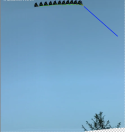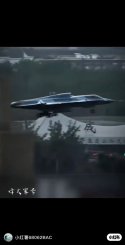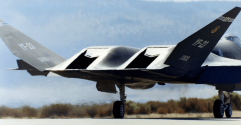A comment from guancha.com (resource is 方方的航空小站).
Translated by Deepseek.
关于某机那个动作到底是不是直角转弯,这个问题在网上吵了好几天了。我这也等了好几天,看看有没有正式的媒体发布,也好跟进一下。
看了这么久,吵的焦点集中在:手机到底有没有转动?以及手机转动能不能造成这样的视觉效果?而真正的问题就是由于前半段动作没有参照物引起的。
个人的解决方法很简单:既然前半段没有参照物,那就不取前半段就好了。只看后半段有参照物的,把参照物对齐就行。
非常幸运的就是当时没风,所以右下角的树枝是很好的参照物。然后效果就出来了。红点是机头顶端位置,用绿线连起来就形成了飞机的运动轨迹。黄线是飞机纵轴示意线,它与绿线的夹角就是飞机当时的侧滑角。
The debate over whether that aircraft maneuver was a 90 degree turn has been ongoing online for days. I’ve waited to see if official sources would release statements for further clarification.
The core dispute revolves around two questions: Was the recording device rotated during filming, and could such rotation produce the observed visual effect? The ambiguity arises from the lack of reference points in the maneuver’s initial phase.
My approach is straightforward: Exclude the unreferenced first segment and analyze only the latter half with visible reference points. Fortunately, windless conditions allowed the branches in the lower-right corner to serve as reliable markers.
The red dots mark the aircraft’s nose position, connected by green lines to trace its flight path. The yellow line represents the longitudinal axis, and its angle relative to the green line indicates the sideslip angle during the maneuver.

根据这组图,可以看到:
1,飞机最后的运动轨迹的确是有了明显变化
最后1帧的侧滑角几乎归零,也就是说飞机纵轴的方向就是飞机的运动方向(蓝线)。对比绿线和蓝线的角度,有没有转弯这是很显然的,当然,没有直角那么夸张。
2,整个运动过程,带有明显的大侧滑角
这说明了几点:
1)飞机一定有航向推力矢量控制,否则做不出这个动作,也无法稳定飞行。
2)就飞机外形来看,很难布置常见的转向喷管或者折流板,因此其航向推力矢量控制很可能采用了新机制。
3)大侧滑角带来的就是巨大的左右升力差。如果是常规设计,利用气动舵面修正,那么由于左副翼正偏角度过大,反而导致左翼首先失速并持续发展,形成所谓的机翼自转并最终进入不可挽回的尾旋。既然这一切都没有出现,那么很可能该机除了航向推力矢量外,在横向控制上也引入了推力矢量——还记得吧,F-22的TVC仅用于俯仰控制。
以下是个人看法:
1)该动作是迄今为止独一无二的机动动作,还没有在其它飞机上见过。
2)该动作不是过失速机动,很明显此时飞机迎角并不大,远远谈不上“过失速”。因此只能称作”非常规机动”。
3)目前所有已知的过失速机动,带大侧滑角的不少,比如:敲钟、落叶飘、猫鼬、超大迎角滚转等等。但是其共同点在于,大侧滑角都是在飞机拉到过失速迎角之后、处于低速状态下才出现的。
像视频中这样,直接简单粗暴地在平飞中扭了一个大侧滑角出来,这个真的从未见过。就其效果而言,有点像1990年代曾经流行过的“直接力控制”。但当年的“直接力控制”只停留在方案上,在现实中究竟是个什么效果,从来没见过。
Based on this set of images, the following can be observed:
- The aircraft's flight trajectory shows a clear change in its final phase.
In the last frame, the sideslip angle nearly returns to zero, meaning the aircraft's longitudinal axis aligns with its direction of movement (blue line). Comparing the angles between the green and blue lines, it's evident that a turn occurred—though not as extreme as a right-angle turn.
- The entire maneuver exhibits a pronounced sideslip angle, indicating several key points:
a) The aircraft must have yaw-axis thrust vector control (TVC); otherwise, this maneuver and stable flight would be impossible.
b) Given the aircraft's configuration, conventional yaw control methods (such as thrust-deflecting nozzles or baffles) appear unlikely. This suggests a novel yaw-axis TVC mechanism.
c) The large sideslip angle creates significant asymmetric lift. In conventional designs, attempting to correct this via aerodynamic control surfaces (e.g., excessive left aileron deflection) would induce left-wing stall, potentially triggering an uncontrollable spin. Since this did not occur, the aircraft likely employs thrust vectoring for lateral control as well—unlike the F-22, where TVC is limited to pitch control.
Personal observations:
- This maneuver is unprecedented and has not been observed in other aircraft.
- It is not a post-stall maneuver (e.g., Pugachev's Cobra, Kulbit, or Herbst maneuver), as the angle of attack remains modest—far below stall thresholds. It should instead be classified as an unconventional maneuver.
- Known post-stall maneuvers (e.g., Bell Strike, Falling Leaf, Mongoose, or high-AOA rolls) typically involve high sideslip angles only after achieving post-stall conditions at low speeds.
What we see here—a sudden, high-sideslip maneuver initiated from level flight—is entirely novel. The effect resembles 1990s conceptual
direct force control schemes, but those remained theoretical; their real-world performance was never demonstrated.






